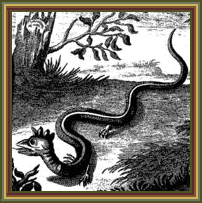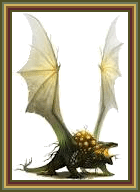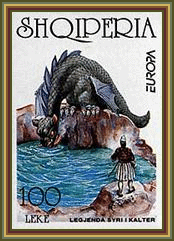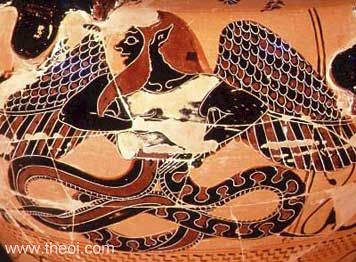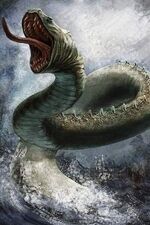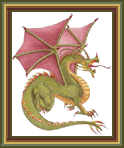. He was the source of devastating storm winds which issued forth from that dark nether realm.
Later poets described him as a volcanic-daimon,
trapped beneath the body of Mount Aitna in Sicily. In this guise he was
closely identified with the Gigante
.
Typhoeus was so huge that his head was said to brush
the stars. He appeared man-shaped down to the thighs, with two coiled
vipers in place of legs. Attached to his hands in place of fingers were a
hundred serpent heads, fifty per hand. He was winged, with dirty matted
hair and beard, pointed ears, and eyes flashing fire. According to some
he had two hundred hands each with fifty serpents for fingers and a
hundred heads, one in human form with the rest being heads of bulls,
boars, serpents, lions and leopards. As a volcano-daimon, Typhoeus
hurled red-hot rocks at the sky and storms of fire boiled from his
mouth.
, but Thor will only walk nine paces before dying himself, of the serpent's poisonous venom.
Loki was punished by the gods as a result of his betrayal; he was
placed in the deepest depths of Hel, with Jormungandr dripping poison in
his face. He was, however, allowed a respite. His wife stood next to
him, and caught the drops of poison in a bowl before they could strike
his face. Periodically, however, she would have to empty the bowl over
his face, and he would writhe in agony, creating earthquakes. So was
Jormungandr caught, stuck to a rock in the deepest pit in Hel, torturing
Loki forever.
In one adventure, Thor encounters Jörmungandr in the form of a colossal cat, disguised by the giant king
's
illusionary magic. As one of the challenges set by Útgarða-Loki, Thor
must lift the cat, and though he is unable to lift such a monstrous
creature as the Midgard snake, he manages to lift it far enough that it
lets go of the ground with one of its four feet. When Útgarða-Loki later
reveals he deceived him it seemed like an incredible heroic feat.
Long ago, Thor decided to catch Jormungandr, and kill him. This would
prove difficult as the Midgard Serpent reached almost around the whole
world and lay in the deepest depth of the ocean. But Thor did not
despair. He took his trusty hammer and went to the giant Hymir, who went
fishing. Hymir was friendly, and let Thor sleep in his house, and said
he could go fishing with him the next morning. The next morning, Thor,
who had to provide his own bait, went to Hymir's cattle pen, and took
the largest ox's head with him to use as bait. He got into the boat with
Hymir, and started rowing. Soon they had reached where Hymir usually
went fishing, and wanted to stop, but Thor rowed on. "This is enough!'
the giant soon said. "We may even chance upon the Midgard Serpent here,
and we will go no further.' Thor threw out his unbreakable line, and the
ox's head sunk to the bottom, right in front of the Serpent, who
greedily devoured it whole. Immediately it pulled so hard on the line
that Thor broke his knuckles upon the edge of the boat, and got very
angry. He pulled up the Mudgard serpent, thrashing and well, from the
bottom of the sea. He had almost reached the surface, and Thor was
readying his hammer to strike it, when the scared Hymir cut the line.
The serpent sank back to the bottom of the sea, and Thor threw his
hammer at it. Then he punched the giant so hard he fell overboard, and
waded back through the sea to the far-away shore.
Ben Vair Dragon:
In Argylllshire, Scotland - The hero of this story was a sea captain,
Charles the Skipper. He came up with a trap to rid the area of a dragon
that was the bane of all. He anchored his ship a little way offshore,
and built a bridge from the vessel to the beach.
The bridge was made of barrels lashed together and studded with metal
spikes. The sea captain began to roast some meat on his ship. The smell
wafted to the dragon’s lair and it came swooping down to the beach. As
it began to crawl across the bridge of barrels, the spikes pierced its
hide and one struck the dragon’s vulnerable spot. The massive beast
expired on the bridge long before it got to the ship.
INDIAN NAGAS AND DRACONIC PROTOTYPES

AT A very early period northern India acquired a mixed population
composed of Conquerors and more peaceful immigrants from the west and
north, which became amalgamated with whatever remained in the previous
inhabitants; and an antique form of Sanscrit spoken by the invaders
became the general language. They appear, as far back as they can be
traced, to have been an agricultural and cattle-breeding people, using
horses, settled mainly in towns and villages, and considerably advanced
towards civilization. Their religious ideas, at least within the
millennium next preceding the beginning of the Christian era, as we
learn from the Vedas, were expressed in a mythology of nature-gods
related to the sun and sky and, especially to the weather as affecting
grass and crops, with which was mixed a very ancient and fetishistic
serpent-worship. In short these ancestral Hindoos much resembled in
ideas the people of Elam and Chaldea with whom they were already in
communication, but far exceeded them in their reverence of
serpents--naturally, perhaps, as these are more numerous and dangerous
in India than in Mesopotamia.
Their particular object in serpent-veneration was the deadly cobra,
called naga; and every one of these hooded reptiles was regarded as the
living incarnation or representative of a great and fearful company of
mythological nagas. These were demi-gods in various serpentine forms,
uncertain of temper and fearful in possibilities of harm, whose 'kings'
lived in luxury in magnificent palaces in the depths of the sea or at
the bottom of inland lakes. They were also said to inhabit an underworld
(Patala Land), and were believed to control the clouds, produce
thunderstorms, guard treasures, and do weird and marvellous things in
general. Many feats were attributed to them which could be performed
only by beings having human powers and faculties, whence they were said
to assume human form from time to time; and stories are told in the
writings of 'naga-people' appearing mysteriously and then escaping to
the depths of the ocean--probably developed from incidents in which wild
strangers had raided the coast and when discovered had fled over the
horizon in their boats. The ruder tribes, which were most addicted to
cobra-worship, and were despised by the Brahmanic class, were known as
Naga men or simply Nagas. This cult persists in remote districts to this
day, and is especially vigorous in the rough country of northern Burma
and Siam, where temples of snake-worship are yet maintained. Doubtless
it formerly prevailed beyond India all over the Malay Peninsula and
among the unknown aborigines of China.
It must be remembered in connection with these facts that the
semi-civilized inhabitants of the Northwest were largely a maritime
people. Living along the great Indus River they early took to the sea
and became daring navigators, voyaging far eastward on both plundering
and trading expeditions. The civilization of both Burma and Indochina,
according to Oldham's investigations, is shown by history as well as
legend to be owing to invaders from India, who introduced there not only
ideas of a settled life and trade, but taught the notions of
naga-worship, and later Buddhistic doctrines and practices throughout
southern China, Java, Sumatra and Celebes. Buddha himself refers to such
voyages, in which no doubt religious missionaries sometimes
participated.
Mingled with this was direct reaching from Babylon and Egypt, as has
already been mentioned. "Within twenty years of the introduction of the
Phoenician navy into the Persian Gulf by Sennacherib traders from the
Red Sea arrived in the gulf of Kiao-Chau, and soon established colonies
there." This was in the middle of the sixth century B.C. "They came on
ships bearing bird or animal heads and two big eyes on the bow, and two
large steering-oars at the stern--distinctly Egyptian methods of
ship-building."
Into the Vedic civilization of northern India, was introduced, about
the seventh century B.C., the more spiritual and unselfish cult of
Buddhism. Its most difficult problem was the overcoming of
cobra-worship, and as this proved impossible, the Buddhists were
compelled to be content with trying to improve the worst features of
ophiolatry among the Naga tribes; but this conciliatory attitude seems
to have led to a weakening and corruption of the gospel preached by
Buddha and his first apostles. Legends, though conflicting, indicate
this. It is related, for example, that a naga king foretold the
attainment of Gautama to Buddhahood; and the cobra-king who lived in
Lake Mucilinda sheltered Lord Buddha for seven days from wind and rain
by his coils and spreading hoods, as is represented in many antique
pictures and sculptures. At any rate a schism developed over this
matter, resulting in the southern Buddhists teaching less strict
doctrine with reference to the old beliefs, which became known as the
Manhayana school.
The nagas' ability to raise clouds and thunder when out of temper was
cleverly absorbed by this school into the highly beneficent power of
giving rain to thirsty earth, and so these dreadful beings became by the
influence of Buddha's 'Law' blessers of men. "In this garb," as Dr.
Visser' points out, they were readily identified with the Chinese
dragons, which were also beneficent rain-gods of water"; and it was this
modified, semi-Hindoo, Manhayana conception of Buddhism, with its
tolerance of serpent-divinity, which was carried by wandering
missionaries and traders during the later Han period into China and
eastward.
Visser ascertained, in his profound examination of this serpent-cult,
that in later Indian, that is Greco-Buddhist, art, the nagas appear as
real dragons, although with the upper part of the body human. "So we see
them on a relief from Gandahara, worshipping the Buddha's alms-bowl in
the shape of big water-dragons, scaled and winged, with two horse-legs,
the upper part of the body human." They may be found represented even as
men or women with snakes coming out of their necks and rising over
their heads, which recalls the prime fiends of Persian legend, and also
the prehistoric pictures of the more or less mythical Chinese sage Fu
Hsi.
The four classes into which the Indian Manhayanists divided their nagas were (quoting Visser):
Heavenly Nagas--who uphold and guard the heavenly palace.
Divine Nagas--who cause clouds to rise and rain to fall.
Earthly Nagas--who clear out and drain off rivers, opening outlets.
Hidden Nagas--guardians of treasures.
This corresponds closely with Professor Cyrus Adler's list (Report U.
S. National Museum, 1888), of the four kinds of Chinese dragons: "The
early cosmogonists enlarged on the imaginary data of previous writers
and averred that there were distinct kinds of dragons proper--the
t'ien-lung or celestial dragon, which guards the mansions of the gods
and supports them so that they do not fall; the shen-lung or spiritual
dragon, which causes the winds to blow and produces rain for the benefit
of mankind; the ti-lung or dragon of the earth, which marks out the
courses of rivers and streams; and the fu-ts'ang-lung or dragon of
hidden treasures, which watches over the wealth concealed from mortals.
Modern superstition has further originated the idea of four dragon
kings, each bearing rule over one of the four seas which form the
borders of the habitable earth."
In a Tibetan picture referred to by Visser nagas are depicted in
three forms: Common snakes guarding jewels; human beings with four
snakes in their necks; and winged sea-dragons, the upper part of the
body human, but with a horned, ox-like head, the lower part of the body
that of a coiling dragon. This shows how a queer mixture of Chaldean,
Persian and Hindoostanee elements reached Tibet by very ancient caravan
roads north of the Himalayan ranges; and it throws light on one possible
origin of the four-legged figure adopted by the Chinese, especially in
the northern marches of the empire where the inhabitants were open to
Bactrian, Scythian, and other western influences.
That composite animal-form of the rain-god of the Euphrates people,
the horned sea-goat of Marduk (immortalized as the Capricornus of our
Zodiac), was also the vehicle of Varuna in India, whose relationship to
Indra was in some respects analogous to that of Ea to Marduk in
Babylonia. In his account of Sanchi and its ruins General Maisey, as
quoted by Smith, states that: "As to the fish-incarnation of Vishnu and
Sakya Buddha, and as to the makara, dragon or fish-lion, another form of
which was the naga of the waters, the use of the symbol by both
Brahmans and Buddhists, and their common use of the sacred barge, are
proofs of the connection between both forms of religion and the far
older myths of Egypt and Assyria." Havell is of the opinion that the
crocodile-dragon which appears in the figure of Siva dancing in the
great temple of Tanjore, may have been older than the eleventh century
when the temple was built. "In the earlier Indian rendering of this
sun-symbolism, as seen in the Buddhist 'horse-shoe' arches," says
Havell, "the crocodile-dragon, the demon of darkness, who swallows the
sun at night and releases it in the morning, is not combined with these
sun-windows until after the development of the Manhayana school."
Sun-worship, serpent-worship, phallicism, and dragons are inextricably interwoven in Oriental mythology.
It is in the Indian makara, I think, that we have the 'link' between
the Western conception and that of the Chinese as to the shape of this
fabulous water-spirit. Yet, all the makaras of Vedic myth are simply a
crocodile in simple form, or else are variants of Marduk's sea-goat with
two front feet only, varied according to the head and body into
antelopes (blackbuck), cats, elephants, etc., all carrying fish-tails.
The Chinese dragon, on the other hand, has nothing of the fish about it,
but is wholly serpent, except its horned and fantastic head and the
fact that it invariably possessed (crocodile-like) four legs and feet
which are quite as like those of a bird as like those of a lion. There
is evidently some significance in the bird-like feet. Can they be a
relic of the introduction ages ago of the Babylonian or Elamite figure
of the rain-god, composed by joining the symbols of Hathor-Sekhet and
Horus? That is to say, do they possibly represent the long-forgotten
falcon of the bright son of Osiris?
"In Chinese Buddhism," Dr. Anderson informs us in his celebrated
Catalogue, "the dragon plays an important part either as a fierce
auxiliary to the Law or as a malevolent creature to be converted or
quelled. Its usual character, however, is that of a guardian of the
faith under the direction of Buddha, Bodhisattvas, or Arhats. As a
dragon king it officiates at the baptism of the Sakyamuni, or bewails
his entrance into Nirvana; as an attribute of saintly or divine
personages it appears at the feet of the Arhat Panthaka, emerging from
the sea to salute the goddess Kuanyin, or as an attendant upon or
alternative form of Sarasvati, the Japanese Benten; as an enemy of
mankind it meets its Perseus and Saint George in the Chinese monarch Kao
Tsu (of the Han dynasty) and the Shinto god Susano'no Mikoto. When this
religion made its way into China, where the hooded snake was unknown,
the emblems shown in the Indian pictures and graven images lost their
force of suggestion, and hence became replaced by a mythical but more
familiar emblem of power."
It was mainly--but not altogether, as we shall see--from Indian
sources that the now familiar four-footed dragon of China became
conventialized through its applications in the several arts of
decoration and devotion; and it seems a fair inference that the
aggressive Buddhist influence of the early centuries of that sect led
Chinese artists to change the smooth, well-proportioned ch'ih-lung of
their forefathers, chin-bearded like the ancient sages, into a sort of
jungle python with the horrifying head and face characteristic of the
countenances of antique Buddhistic images of their demons. To understand
how inhumanly terrible these caricatures of malignant beings in the
guise of humanity may be, one need only glance at drawings of the temple
images exhumed by Sir Aurel Stern from the sand-buried Indo-Chinese
cities of Turkestan, which flourished about the time of which I am
speaking.
Buddhist artists, at first probably aliens, would be likely to depict
the dragon head and face in their attempts to portray the chief
'demon', as they mistakenly regarded the friendly Chinese divinity,
after the same horrifying fashion. Then, to impress the people of the
North, who saw few dangerous snakes, but who did know and fear tigers
and leopards, the artists equipped their frightful-headed serpent with
catlike legs, bird's feet, such tufts of hair as decorate and would
suggest a lion, and a novel ridge of iguana-like spines along its
backbone.
The fully realized dragon, then, as we see it in bronzes or sprawled
across a silken screen, is an invention of decorative artists striving,
during the last 2000 years, to embody a traditional but essentially
foreign idea.
 Mayan mythology emerged from the traditions and religion of a civilization as old as 3,000 years from a vast region called Mesoamerica: territories that are now the Mexican states of Campeche, Chiapas, Quintana Roo, Tabasco, and Yucatan, in addition to some parts of Central America.
Even though many of the texts written by the Mayans were burned on the
arrival of the Spanish, some legends have survived and continue to be
told today.
Mayan mythology emerged from the traditions and religion of a civilization as old as 3,000 years from a vast region called Mesoamerica: territories that are now the Mexican states of Campeche, Chiapas, Quintana Roo, Tabasco, and Yucatan, in addition to some parts of Central America.
Even though many of the texts written by the Mayans were burned on the
arrival of the Spanish, some legends have survived and continue to be
told today. The aluxes are tiny beings, created out of clay that were hidden and in that way they were able to protect its owner. The aluxes
(pronounced ah-lu-shes), had a strong tie to their creator. Once they
were created, they were offered prayer and offerings to make them come
to life.
The aluxes are tiny beings, created out of clay that were hidden and in that way they were able to protect its owner. The aluxes
(pronounced ah-lu-shes), had a strong tie to their creator. Once they
were created, they were offered prayer and offerings to make them come
to life. Pronounced
eesh-ta-bai, this legend tells the story of two beautiful sisters. One
of them was known as the sinner and the other as the good one. The first
one was not wanted because she gave herself to love, but in reality was
loved by the sick and the weak ones. The second one was appreciated by
the town, but in the interior she was rigid and incapable of loving
those around her.
Pronounced
eesh-ta-bai, this legend tells the story of two beautiful sisters. One
of them was known as the sinner and the other as the good one. The first
one was not wanted because she gave herself to love, but in reality was
loved by the sick and the weak ones. The second one was appreciated by
the town, but in the interior she was rigid and incapable of loving
those around her. Sac-Nicte
means white flower. She was born in Mayapan: the powerful alliance that
lived in peace—Mayab, Uxmal, and Chichen Itza. Canek means black
serpent, a brave prince with a kind heart. When he turned 21 years of
age, he was chosen as king of Chichen Itza. That same day he met
princess Sac-Nacte. She was 15 years of age. Both quickly fell in love;
however Sac-Nicte was destined to be married with young Ulil, prince of
Uxmal.
Sac-Nicte
means white flower. She was born in Mayapan: the powerful alliance that
lived in peace—Mayab, Uxmal, and Chichen Itza. Canek means black
serpent, a brave prince with a kind heart. When he turned 21 years of
age, he was chosen as king of Chichen Itza. That same day he met
princess Sac-Nacte. She was 15 years of age. Both quickly fell in love;
however Sac-Nicte was destined to be married with young Ulil, prince of
Uxmal. Uxmal
is pronounces ush-mal. The legend says that a long time ago in the
ancient Mayan city, there lived an ancient woman that worked as an
oracle in the city. The woman was unable to conceive children and
therefore asked the god Chic Chan to bring her the shell of a large
turtle. A few months later, a tiny green dwarf with red hair was born.
Uxmal
is pronounces ush-mal. The legend says that a long time ago in the
ancient Mayan city, there lived an ancient woman that worked as an
oracle in the city. The woman was unable to conceive children and
therefore asked the god Chic Chan to bring her the shell of a large
turtle. A few months later, a tiny green dwarf with red hair was born.